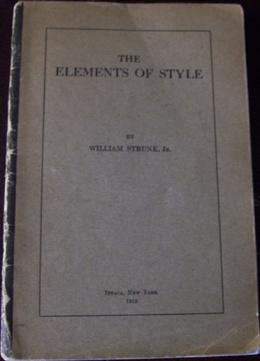Some writing lessons from the elements of style part 2

William Strunk's The Elements of Style, first published in 1918 and available for free in the public domain, evolved into a classic writer's manual by Strunk and E.B White. Even in 1918, Strunk described the key points of good writing style that show up in the dozens of textbooks I've used to teach numerous college writing courses. Strunk's book could be called the grandfather of all English Style guides and writing textbooks. Here is part 2 of my lessons from the Elements of Style. These have more to do with writing style than with punctuation.
On paragraphs.
One paragraph per topic - This is a point I make constantly in my teaching. Many students want to lump everything into one long wad of type. The paragraph, though, is a unit of writing whether in an essay or in a report. In essays, paragraphs tend to be longer and reports they are short segments of information. Often in student work, I also see something I call the "floating paragraph" which is really a jumble of sentences between two large paragraphs that jumps around to different topics.
If your paragraph is long then try to divide it up into shorter segments. Decide what you are doing: are you describing, giving background information developing another point of an argument or giving examples? Focusing each paragraph on one topic only will make your document easy to read. In general, also avoid using one-sentence paragraphs according to Strunk, unless you are creating a transition.
The parts of a paragraph: Paragraphs have three main sections: the topic sentence, the supporting sentences and the final or concluding sentence.
Begin each paragraph with a topic sentence. The topic sentence usually is a statement about a subject area that tells the reader what will be developed in the paragraph.A lot of my students initially in a paragraph course are weak in topic sentences and tend to bury them in the middle of a paragraph. According to Strunk, the topic sentence should be the first sentence in the paragraph, or at least very close to the beginning. Just make sure the previous sentence(s) lead into it. .If the paragraph is part of a larger work, in the topic sentence make reference to what preceded it.
Each sentence in your paragraph including the ending sentence should work hard to support the paragraph and the final sentence should serve to bring the paragraph to a close.
Effective writing style
Use the active voice - This is a favorite of mine, one I have been preaching for years. The active voice is the most powerful and vigorous form of the language. It livens up description, narration and all forms of expository writing. It is the direct form of the language, which for the most part lends itself to creating direct, conversational crisp prose. The passive voice, on the other hand, though grammatically correct, tends to be less direct, and lends itself to more wordy constructions.
Compare:
- The director chose her.
- She was chosen by the director.
The latter sentence is indirect, more wordy and not as crisp as the first sentence. ,
Don't get me wrong, the passive voice has its place. It works well when you want to be gentle with your reader ( e.g. "credit cannot be granted now" ), or when you want to be indirect and not identify who is responsible for an action ( "a decision was made"). For the most part, this tone is detached and not as effective for connecting with your reader.
Compare:
- There were a great number of twigs lying on the lawn after the storm
- Twigs covered the lawn after the storm
- The sound of music in the hallway could be heard
- .Somewhere in the hallway the music played.
- The reason that he left school was because his health became impaired.
- His failing health forced him to leave school.
Definite assertions:
In using the active voice you can make definite assertions and write with more precision.
Compare: He was not very often on time. He usually came late.
Use positive instead of negative:
This give your writing a crisp reader-friendly tone.
Compare:
- He did not think that studying Latin was much use.
- He thought the study of Latin useless.
Instead of
- not honest say dishonest
- did not remember say forgot
- did not pay any attention say ignored
- did not have much confidence in say distrusted
Use definite, specific, concrete language
Vagueness is your enemy in just about all forms of writing. This where, as an instructor I take off marks. Use numbers where you can (instead of saying revenue increased a lot, say it increased by 20%).
Instead of saying the whether was unfavorable, say that we had a snowstorm. In simple parlance we say "show, don't tell: .
Get rid of needless words
Again, this is a point I make repeatedly in all my classes. Make sure that each word in your sentence works for you. The best writing is concise. That doesn't mean you short change the reader for information, but does mean you say it in as few words as possible. The best way to do this is to edit scrupulously and ask yourself if you can take the words out, or say it more briefly.
Consider the following
- Instead of saying as to whether why not say whether
- Instead of saying no doubt, why not say doubtless
- Instead of saying in a hasty manner, why not say hastily
- Instead of saying due to the fact that why not say because
Download the elements of style free
- The Elements of Style - William Strunk Jr. | Feedbooks
The Elements of Style is an American English writing style guide. It is one of the most influential and best-known prescriptive treatments of English grammar and usage in the United States. It originally detailed eight elementary rules of usage, ten
Where to find The Elements of Style
Other grammar hubs
- What are multi word verbs
What are multi-word verbs? As their name suggests they are verbs that are made up up more than one word. Usually this involves a verb, and a word (often a preposition) a particles (some multi-word verbs have more than one particle)/ articles can be a - Some lessons from the elements of style- Part 1
The Elements of Style first appeared in 1918. Written in 1918, the most updated version by William Strunk Jr. and E.B. White is a favorite reference manual for those of us who write. I recently took a look at the Strunk's first version of the book, a - Different types of nouns
For many students of English, understanding the core parts of speech is very important. The noun is one of these, and there are different types of nouns in English. What exactly are nouns anyways? A noun describes a person, place or thing. I'm sure y - Different kinds of adjectives
Adjectives can certainly be confusing to native and non-native speakers alike. Many learners tend to be more concerned with an adjective's meaning rather than its grammar. So here is some information about understanding about different kinds of adjec - Five common grammar mistakes students make, and how ...
f you want to improve your grade by 5-10 percent on your winter term papers, then you need to avoid these five common grammar mistakes my students make on their assignments. Subject-verb agreement Sentence fragments Run-on sentences Comma splices Apo - TOEIC vs TOEFL IBT
f English is not you're first language and you're planning to go to a university where instruction is English or to work for firm with a global presence, then you may find yourself confronting with having to take either a TOEFL test or a TOEIC test. - Different kinds of verbs
For anyone who struggles with the English language, one solution is knowing and understanding about different kinds of verbs and their functions.









